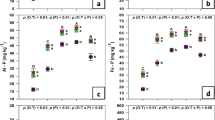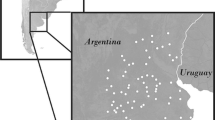Abstract
The soil organic matter (OM) content of soils in a long-term fertiliser field trial (Winchmore, New Zealand) are similar (P > 0.05) despite >60 years application of different phosphorus (P) rates. As the net primary productivity increased with P addition, greater losses of carbon (C) occur concomitantly with increased P fertility. Several hypotheses have been proposed to explain the mechanisms, including C leaching, increased earthworm activity or elevated rates of microbial activity. In this study, we found support for both direct and secondary effects of soil P on soil C through impacts on the soil microbial community. Microbial biomass, inferred through quantification of hot water extractable C, increased with soil P status and decreased with C/P ratio (P < 0.001). However, the microbial biomass had no relationship with soil organic C content (P = 0.485). Mineralisation of C substrates added to soil also increased with soil P status (total P, R 2 = 0.84; P < 0.001). These results indicated potential conditioning of the microbial community for rapid C cycling. Utilisation of different C compounds was clustered by cophenetic similarity; a distinct group of ten carbon compounds was identified for which rates of mineralisation were strongly associated with soil P status and microbial biomass. However, this alteration of microbial community size and activity was not reflected in abundances of selected oligotrophic and copiotrophic taxa. As such, the alteration may be due to changes in the abundances of all taxa, i.e. a general community response.





Similar content being viewed by others
References
Anderson KA (1996) Micro-digestion and ICP-AES for the determination of macro and micro elements in plant tissue. At Spectrosc:30
Bacchetti De Gregoris T, Aldred N, Clare AS, Burgess JG (2011) Improvement of phylum- and class-specific primers for real-time PCR quantification of bacterial taxa. J Microbiol Meth 86:351–356
Bais HP, Weir TL, Perry LG, Gilroy S, Vivanco JM (2006) The role of root exudates in rhizosphere interactions with plants and other organisms. Annu rev Plant Biol 57:233–266
Barns SM, Takala SL, Kuske CR (1999) Wide distribution and diversity of members of the bacterial Kingdom Acidobacterium in the environment. Appl Environ Microb 65:1731–1737
Blakemore LC, Searle PL, Daly BK (1972) Methods for chemical analysis of soils. NZ Soil Bureau Scientific Report 10A
Bünemann EK, Heenan DP, Marschner P, McNeil AM (2006) Long term effects of crop rotation, stubble management and tillage on soil phosphorus dynamics. Aust J Soil Res 44:611–618
Campbell CD, Chapman SJ, Cameron CM, Davidson MS, Potts JM (2003) A rapid microtiter plate method to measure carbon dioxide evolved from carbon substrate amendments so as to determine the physiological profiles of soil microbial communities by using whole soil. Appl Environ Microb 69:3593–3599
Carbonetto B, Rascovan N, Álvarez R, Mentaberry A, Vázquez MP (2014) Structure, composition and metagenomics profiles of soil microbiomes associated with agricultural land use and tillage systems in Argentine pampas. PLoS One 9:e99949
Cederlund H, Wessén E, Enwall K, Jones CM, Juhanson J, Pell M, Philippot L, Hallin S (2014) Soil carbon quality and nitrogen fertilization structure bacterial communities with predictable responses of major bacterial phyla. Appl Soil Ecol 84:62–68
Chen X, Daniell TJ, Neilson R, O’Flaherty V, Griffiths BS (2014) Microbial and microfaunal communities in phosphorus limited, grazed grassland change composition but maintain homeostatic nutrient stoichiometry. Soil Biol Biochem 75:94–101
Clarke KR (1993) Non-parametric multivariate analysis of changes in community structure. Aust J Ecol 18:117–143
Condron LM, Black A, Wakelin SA (2012) Effects of long-term fertiliser inputs on the quantities of organic carbon in a soil profile under irrigated grazed pasture. New Zeal J Agric Res 55:161–164
Daufresne T, Loreau M (2001) Elemental stoichiometry, primary producer-decomposer interactions, and ecosystem persistence. Ecology 82:3069–3082
Fierer N, Jackson JA, Vilgalys R, Jackson RB (2005) Assessment of soil microbial community structure by use of taxon-specific quantitative PCR assays. Appl Environ Microb 71:4117–4120
Fierer N, Bradford MA, Jackson BB (2007) Towards an ecological classification of soil bacteria. Ecology 88:1354–1364
Gardes M, Bruns TD (1993) ITS primers with enhanced specificity for basidiomycetes—application to the identification of mycorrhizae and rusts. Mol Ecol 2:113–118
Ghani A, Dexter M, Perrott K (2003) Hot-water extractable carbon in soils: a sensitive measurement for determining impacts of fertilisation, grazing and cultivation. Soil Biol Biochem 35:1231–1243
Ghani A, Müller K, Dodd M, Mackay A (2010) Dissolved organic matter leaching in some contrasting New Zealand pasture soils. Eur J Soil Sci 61:525–538
Haygarth PM, Bardgett RD, Condron LM (2013) Phosphorus and nitrogen cycles and their management. In: Gregory PJ, Nortcliff S (eds) Russell’s soil conditions and plant growth, 12th edn. Wiley-Blackwell, New York, pp 132–159
Haynes RJ, Williams PH (1993) Nutrient cycling and soil fertility in the grazed pasture ecosystem. Adv Agron 49:119–199
Hinds AA, Lowe EE (1980) Application of the Berthelot reaction to the determination of ammonium-N in soil extracts and soil digests. Commun Soil Sci Plan 11:469–475
Inouye RS, Huntly NJ, Tilman D, Tester JR, Stillwell M, Zinnel KC (1987) Old-field succession on a Minnesota sand plain. Ecology 68:12–26
Keeney DR, Bremner JM (1966) Comparison and evaluation of laboratory methods of obtaining an index of soil nitrogen availability. Agron J 58:498–503
Kirkby CA, Richardson AE, Wade LJ, Batten GD, Blanchard C, Kirkegaard JA (2013) Carbon-nutrient stoichiometry to increase soil carbon sequestration. Soil Biol Biochem 60:77–86
Lane DJ (1991) 16S/23S rRNA sequencing. In: Stackebrandt E, Goodfellow M (eds) Nucleic acid techniques in bacterial systematics. John Wiley & Sons, Chichester, pp 115–175
MacArthur R, Wilson E (1967) The theory of island biogeography. Princeton University Press, Princeton, New Jersey
Mander C, Wakelin S, Young S, Condron L, O’Callaghan M (2012) Incidence and diversity of phosphate-solubilising bacteria are linked to phosphorus status in grassland soils. Soil Biol Biochem 44:93–101
McClean EO (1982) Soil pH and lime requirement. In: Page AL, Miller RH, Keeney DR (eds) Methods of soil analysis. Part 2. Chemical and microbiological properties, Agronomy monograph number, vol 9. Soil Science Society of America, Madison, WI, pp 199–224
McDowell RW (2010) Is cadmium loss in surface runoff significant for soil and surface water quality: a study of flood-irrigated pastures? Water air Soil Poll 209:133–142
McDowell RW, Condron LM (2012) Phosphorus and the Winchmore trials: review and lessons learnt. New Zeal J Agr res 55:119–132
McGill BW, Cole CV (1981) Comparative aspects of cycling of organic C, N, S and P through the soil organic matter. Geoderma 26:267–286
Metherell AK (2003) Management effects on soil carbon storage in New Zealand pastures. Proceedings of the New Zealand Grassland Association 65:259–264
Murphy J, Riley JP (1962) A modified single solution method for the determination of phosphate in natural water. Anal Chim Acta 27:31–36
Muyzer G, De Waal EC, Uitterlinden AG (1993) Profiling of complex microbial populations by denaturing gradient gel electrophoresis analysis of polymerase chain reaction-amplified genes coding for 16S rRNA. Appl Environ Microbiol 59:695–700
Nguyen ML, Rickard DS, McBride SD (1989) Pasture production and changes in phosphorus and Sulphur status in irrigated pastures receiving long-term applications of superphosphate fertiliser. New Zeal J Agr Res 32:245–264
Overmann J, Coolen MJL, Tuschak C (1999) Specific detection of different phylogenetic groups of chemocline bacteria based on PCR and denaturing gradient gel electrophoresis of 16S rRNA gene fragments. Arch Microbiol 172:83–94
Peiffer JA, Spor A, Koren O, Jin Z, Green Tringe S, Dangl JL, Buckler ES, Ley RE (2013) Diversity and heritability of the maize rhizosphere microbiome under field conditions. PNAS 110:6548–6553
R Core Team (2016) R: a language and environment for statistical computing. R Foundation for Statistical Computing, Vienna
Saggar S, Hedley MJ, White RE (1990) A simplified resin membrane technique for extracting phosphorus from soils. Fer Res 24:173–180
Schipper LA, Dodd MB, Fisk LM, Power IL, Parenzee J, Arnold G (2011) Trends in soil carbon and nutrients of hill-country pastures receiving different phosphorus fertilizer loadings for 20 years. Biogeochemistry 104:35–48
Searle PL (1988) The determination of phosphate-extractable sulphate in soil with an anion-exchange membrane. Commun Soil Sci Plan 19:1477–1493
Sparling G, Vojvodić-Vuković M, Schipper LA (1998) Hot-water-soluble C as a simple measure of labile soil organic matter: the relationship with microbial biomass C. Soil Biol Biochem 30:1469–1472
Strickland MS, Callaghan MA, Davies CA, Lauber CL, Ramirez K, Richter DD, Fierer N, Bradford MA (2010) Rates of in situ carbon mineralization in relation to land-use, microbial community and edaphic characteristics. Soil Biol Biochem 42:260–269
Uren NC (2000) Types, amounts, and possible functions of compounds released into the rhizosphere by soil-grown plants. In: Pinton R, Varanini Z, Nannipieri P (eds) The rhizosphere: biochemistry and organic substances at the soil-plant interface. Marcel Dekker, New York, pp 19–40
van Elsas JD, Trevors JT, Wellington EMH (1997) Modern soil microbiology. Marcel Dekker Inc, New York
Volk C, Wood L, Johnson B, Robinson J, Zhu HW, Kaplan L (2002) Monitoring dissolved organic carbon in surface and drinking waters. J Environ Monitor 4:43–47
Waid JS (1960) The growth of fungi in the soil. In: Parkinson D, Waid JS (eds) The ecology of soil fungi. Liverpool University Press, U.K.
Wakelin SA, Clough TJ, Gerard EM, O’Callaghan M (2013a) Impact of short-interval, repeat application of dicyandiamide on soil N transformation in urine patches. Agric Ecosyst Environ 167:60–70
Wakelin SA, van Koten C, O’Callaghan M, Brown M (2013b) Physicochemical properties of 50 New Zealand pasture soils: a starting point for assessing and managing soil microbial resources. New Zeal J Agr Res 56:248–260
Wakelin SA, MacDonald LM, O’Callaghan M, Forrester ST, Condron LM (2014) Soil functional resistance and stability are linked to different ecosystem properties. Austral Ecol 39:522–531
Warcup JH (1960) Methods for isolation and estimation of activity of fungi in soil. In: Parkinson D, Waid JS (eds) The ecology of soil fungi. Liverpool University Press, UK
Yarza P, Yilmaz P, Pruesse E, Glöckner FO, Ludwig W, Schleifer K-H, Whitman WB, Euzéby J, Amann R, Rosselló-Móra R (2014) Uniting the classification of cultured and uncultured bacteria and archaea using 16S rRNA gene sequences. Nature Rev Microbiol 12:635–645
Zhang H, Ding W, Yu H, He X (2015) Linking organic carbon accumulation to microbial community dynamics in a sandy loam soil: result of 20 years compost and inorganic fertilizers repeated application experiment. Biol Fert Soils 51:137–150
Author information
Authors and Affiliations
Corresponding author
Electronic supplementary material
Supplementary Table 1
(XLSX 12 kb)
Rights and permissions
About this article
Cite this article
Wakelin, S., Condron, L., Gerard, E. et al. Long-term P fertilisation of pasture soil did not increase soil organic matter stocks but increased microbial biomass and activity. Biol Fertil Soils 53, 511–521 (2017). https://doi.org/10.1007/s00374-017-1212-2
Received:
Revised:
Accepted:
Published:
Issue Date:
DOI: https://doi.org/10.1007/s00374-017-1212-2




